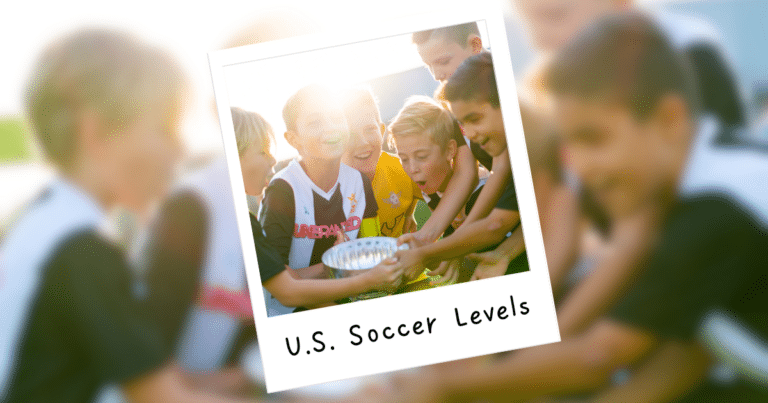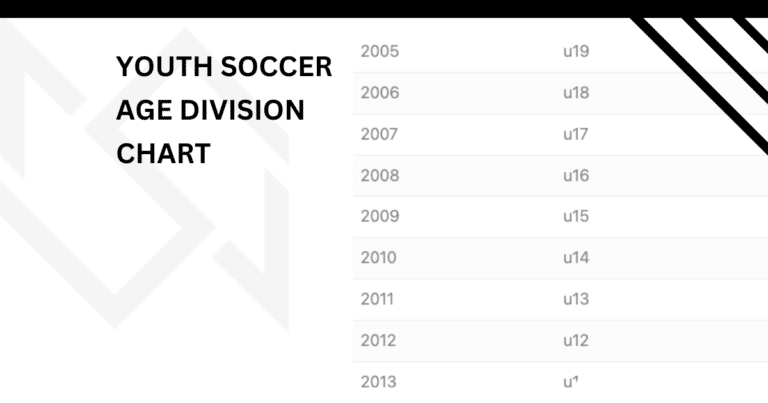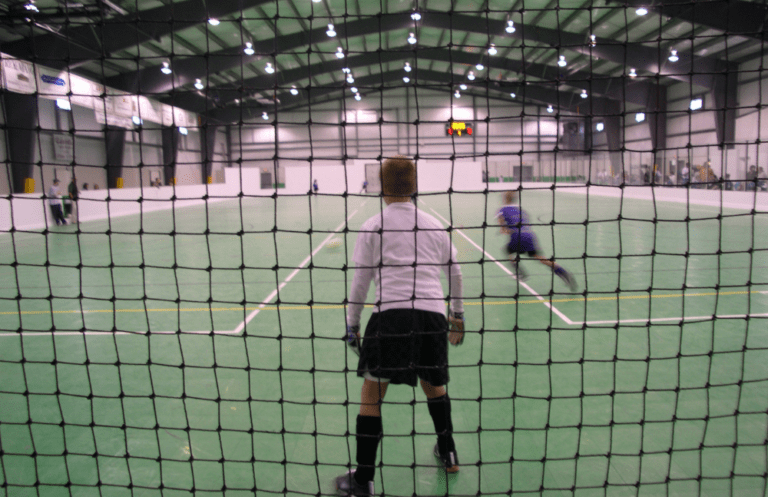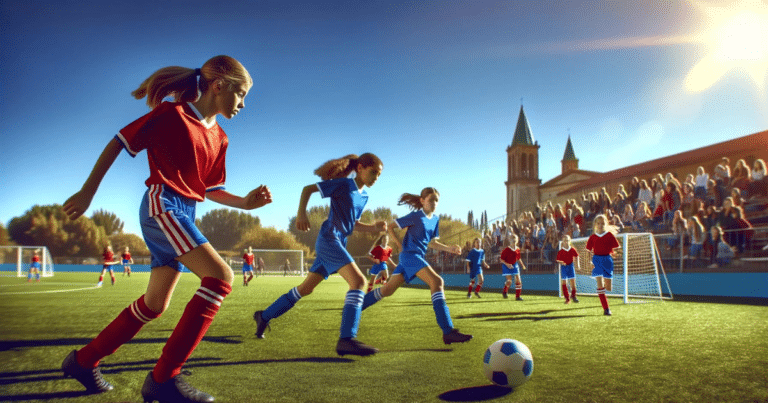How to Play Soccer: All You Need to Know

Soccer is a fun sport played by millions of young kids around the globe. It’s a sport enjoyed by people of all ages, skill levels, genders, ethnicities, and backgrounds.
If you’re new to the sport, this guide will be your savior.
From my experience, you don’t need to spend hours studying the game. You just need to know the basics and then start playing.
I’ve been on three sides of the coin (yes, I know there are only two sides): player, coach, and parent. This is why I think I’m fit to teach you various aspects of soccer including the basics.
Now, let’s get into it!
Understanding the Basics of Soccer
What is the Objective of a Soccer Game?
The objective of soccer is simple: to score more goals than the opposing team.
The team with the most goals at the end of the game is the winner. In most 11v11 leagues, the game can also end in a tie.
The Soccer Field
The soccer field is always rectangular in shape, with a length of between 100-130 yards and a width of between 50-100 yards.
The field is divided into two halves, with a center circle in the middle.
There are penalty areas and goal boxes at each end of the field. The goals are located at the center of each goal line and are eight yards wide and eight feet tall.
Soccer fields are typically natural grass or turf. Most modern youth soccer facilities are made with turf material.
The Soccer Ball
The soccer ball is spherical in shape and weighs between 14-16 ounces. Its circumference is between 27-28 inches and is usually made of leather or synthetic materials. The ball should be inflated to a pressure of between 9-15 psi.
Here’s the size of the ball you will be playing with.
| AGE GROUP | IDEAL SOCCER BALL SIZE |
|---|---|
| 3 years and younger | Size 1 |
| 3-4 years old | Size 2 |
| 5-8 years old | Size 3 |
| 9-12 years old | Size 4 |
| 13 years and older | Size 5 |
The Players on the Field
From U-13 and older, each team has eleven players on the field, including a goalkeeper. The players are assigned different positions such as forwards, midfielders, defenders, and the goalkeeper. You can read more about positions here.
For younger age groups, there are usually nine, seven, or four players on the field for a team. As you go down in age, the fewer players you usually have but the field is also smaller.
Equipment and Gear
To play soccer, you’ll need some basic gear. Here are the three essential pieces of equipment you’ll need:
Soccer Cleats
Soccer cleats are designed footwear with studs or cleats on the bottom to give you better traction on the field.
They are made from lightweight, breathable, and flexible materials. They come in a variety of styles and materials, so it’s important to choose the right pair for your needs.
Soccer Shin Guards
Shin guards are worn under your socks to protect your shins from kicks and collisions with other players.
- Recommended: Best Shin Guards
Soccer Socks
Soccer socks are worn over your shin guards to keep them in place and to provide additional padding. They are longer than your everyday socks.
Today, many youth soccer players wear grip socks with their regular soccer socks.
Understanding Soccer Rules
As with any sport, soccer has its own set of rules and regulations that govern how the game is played.
I would say, besides the offsides rule, soccer is easy to understand. Learning about these rules is essential for any player who wants to succeed on the field.
Game Length
A standard soccer match consists of two halves, each lasting 45 minutes with a 15-minute halftime break.
However, the referee may add additional time at the end of each half to make up for time lost due to injuries, substitutions, or other stoppages in play.
This added time is known as “stoppage time” or “injury time.
Depending on your age, the game length may be shorter. For example, for kids under 9, each half might be twenty minutes.

Offside Rule
As I referenced, the offside rule is probably the most complicated rule of them all! At the same time, it is one of the most important rules in soccer.
Offsides are designed to prevent players from simply hanging out near the opponent’s goal waiting for a pass. This was called ‘cherry picking’ back in my day.
A player is considered offside if they are closer to the opponent’s goal than both the ball and the second-to-last defender when the ball is played to them.
Please note that some younger age groups do not have an offsides rule so check your league’s rules.
Fouls and Penalties
Fouls are an inevitable part of any soccer game.
The referee is responsible for enforcing the rules and penalizing players who break them.
Common fouls include tripping, pushing, and holding. These can result in free kicks, penalty kicks, or even yellow or red cards.
Young kids getting yellow or red cards is very rare in youth soccer but I’ve seen it happen!
A free kick is awarded to the opposing team when a foul is committed outside the penalty area. The player taking the free kick must wait for the referee’s whistle before kicking the ball.
If a foul is committed inside the penalty area, a penalty kick (PK) is awarded. The penalty kick is taken from the penalty spot, 12 yards away from the goal, with only the goalkeeper allowed to defend it.
Basic Skills and Techniques for Soccer
In this section, I will cover some of the essential skills and techniques that you need to know.
Dribbling
Dribbling is the ability to move the ball effectively with your feet. To become a good dribbler, you need to have excellent ball control.
You can practice dribbling by setting up cones and practicing dribbling around them. You can also practice dribbling by playing small-sided games, where you have to dribble past defenders to score.
Passing
Good passing requires accuracy and the ability to control the ball. A good passer can open up the field for their team.
To develop your passing skills, you can practice passing the ball with a partner or against a wall. You can also practice your passing skills during small-sided games, where passing is crucial to creating scoring opportunities.
Shooting
Shooting is the most exciting part of soccer. To become a good scorer, you need to have good technique and accuracy.
You can practice shooting by setting up cones and shooting at them from different angles. You can also work on your accuracy by trying to hit the crossbar.
on as you wake up.
Finding a Soccer Team in Your Area
If you want to play soccer in your area, there are several options available to you.
You can join a town rec, town travel, or club soccer team. Each option has its advantages and disadvantages.
Town Rec Teams
Town rec teams are great for beginners who are just starting out.
These teams are usually open to all skill levels and ages, and they are a great way to meet new people and have fun.
Rec teams typically have a lower cost and less commitment than travel and club teams.
To find a town rec team, check with your local parks and recreation department. They usually have information about registration and team schedules.
Schedules and commitments vary by town and age but you may find games being on weekends and a practice during the week.
Town Travel Teams
Town travel teams are a step up from rec teams in terms of competition and commitment.
These teams usually require tryouts and have a higher cost than rec teams. However, they offer a higher level of play and can be a great way to improve your skills and prepare for club teams.
To find a town travel team, check with your local soccer association or club. They usually have information about tryouts and team schedules.
Looking back on my son’s travel experience, it was a great transition to club soccer.
Club Soccer Teams
Club soccer teams are the most competitive and expensive option for playing soccer in your area.
These teams require a high level of commitment and skill, and they often travel to tournaments and games outside of your local area.
However, club teams offer the highest level of play and can be a great way to prepare for the next level.
Instead of just a fall or spring season, club soccer typically goes year-round with a small break in the winter and summer.
To find a club soccer team, just go over to our directory where you will find the best clubs in your area by age group and league.
Having Fun While Playing Soccer
Playing soccer can be a lot of fun, but it’s important to keep it that way.
When things are fun, you’re more likely to keep pursuing it.
Here are a few tips to help you enjoy playing soccer even more:
- Play with friends: Playing pickup soccer with your friends is a great way to have fun and improve your skills at the same time. You’ll be able to work on passing, shooting, and other skills while having a good time with your friends.
- Try new things: Don’t be afraid to try new things on the field. Experiment with different moves and techniques to keep the game interesting and challenging.
- Stay positive: It’s important to stay positive, even when things aren’t going your way. Instead of getting frustrated or discouraged, focus on what you can do to improve your performance and have a good time on the field.
- Play fair: Playing fair is an important part of having fun while playing soccer. Don’t cheat or play dirty, and always respect the rules of the game.
- Play the FIFA video game: Parents may not like this but I think playing FIFA can help beginner soccer players learn about the game quickly. They can mimic real life and understand the different moves, positions, and strategies.
For players, parents, and coaches, I can’t stress this enough…make sure the kids are having fun!
You want them coming back tomorrow, next week, next month, and next year.

Written By: Beau Bridges
Beau is the founder of SoccerNovo, dedicated to helping players and parents navigate the youth soccer landscape. As a former youth coach and soccer parent, he shares insights on player development, recruiting, and the ever-evolving soccer scene in the U.S.
Let’s connect





